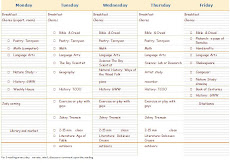I thought it was interesting to come across these just after I did exams with my present 6th grader, who was back then about 4 or 5 years old.
The other thing that was interesting is that my 19 year old saw the papers on my table and started reading them, then answering them as he went along. Some of the questions are obviously general cultural literacy. But it was surprising how he could still answer most of the history questions even after so many years. I think that is probably support for Charlotte Mason's literature-based method.
All the books mentioned were books read that first half of the year, so the kids were doing a lot of reading. Brendan still remembered almost all of the books and also could identify almost all of the quotes.
Aidan was less than 2 years old at this time and very care-intensive, G Tube fed and needing oxygen at intervals, and developmentally about 9 months old. This kind of exam took a lot of energy for me to put together back then, and I don't think I tried it again that year.
HISTORY
Choose one of these saints and tell something about his or her life work and character.
- St Dominic, St Anthony, St Edmund Campion, St Hyacinth, St Therese of Lisieux, St Joan of Arc, St Catherine of Siena, St Francis Xavier
Identify:
- Whose mother dreamed about a barking dog?
- Who travelled to Japan to be a missionary?
- Who lived during the reign of Elizabeth I?
- Who went to war to save France?
Choose one of these martyrs and tell what country and under whose rule they were killed.
- St Thomas a Becket, St Thomas More, St Edmund Campion, St Paul Miki, st Joan of Arc.
Three of these saints were contemporaries(lived at approximately the same time) while one lived later. Pick out the one who lived later.
- Dominic Guzman, Francis of Assisi, Edmund Campion, Hyacinth of Poland
Put MA by the ones who lived in the middle ages and RE by the one who lived in the Renaissance.
Put these Japanese events in order:
- civil war, period of isolation, St Francis Xavier comes to Japan
Write a sentence about three of the following.
- The Crusades, The Black Death, the Tartars, Oda Nobunaga, Richard the Lionhearted, Henry II of England, the Ring of Fire, The Saracens, the Albigensians
Choose one of the following religions or heresies and tell something about it.
- Shinto, Buddhism, Albigensianism, Islam
Identify the quotes:
- "Will no one rid me of this troublesome priest?"
- If all the swords of England were pointed at my head, you threats could not move me."
- "The questions of a fool do not anger a wise man, but the answers of a wise man may anger a fool."
- "The quality of mercy is not strained, but droppeth as the gentle rain from heaven."
- "A pound of flesh."
- "In the raging fire of the world there is no peace."
Geography
- On a map of Asia, mark Japan, the Pacific Ocean, Korea, and China plus as many other areas as you can.
- On a map of Europe, mark as many countries as you can, also the Mediterranean and the English Channel.
Readings
Choose one of the following Shakespeare plays and tell something about the story.
- Merchant of Venice, MacBeth, Taming of the Shrew, A Midsummer Night's Dream
Define:
- samurai, shogun, bushido, chivalry, crusade, heresy, tsunami, kamikaze, quixotic, martyr
Choose one saint's book for a review:
- St Hyacinth, Pope John Paul II, St Dominic, St Edmund Campion, St Francis Xavier, St Anthony of Padua, Heroes of God's Church, Hunters of Souls, If all the Swords in England
Choose one other book:
- Lord of the Rings, Archives of Anthropos, Winds of Light, Bugles and Bonnets, Seven Sleepers, We Were There with Richard the Lionhearted, Knight's Castle, Time Garden
SCIENCE
- Choose one kind of snake, one kind of other reptile or mammal, and one kind of insect or spider.
- Tell what you can about it -- what you have seen yourself, if you have seen one in life or in a picture, and what you know from reading.
- Draw a picture or diagram.
,



No comments:
Post a Comment